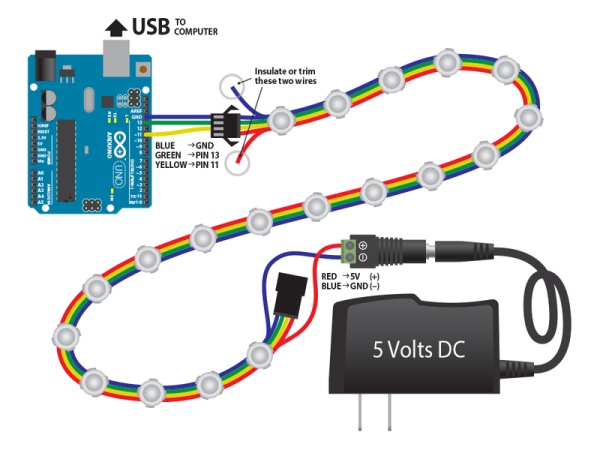This sketch is used by Exercise: WS2801 RGB LED SPI Module.

Full Source Code
The full code is all in one file WS2801LED.ino.
// -*- mode:c++; -*-
/// @file WS2801LED.ino
///
/// @brief Example for driving several WS2801 RGB LED modules over SPI on an Arduino UNO.
///
/// @author Garth Zeglin
/// @date 2014-09-13
///
/// @remarks The WS2801 LED driver has three current controlled LED outputs with
/// 8-bit precision (256 levels). It is controlled over SPI by sending 24 bits
/// of pixel data at up to 25MHz rate. Additional data is then relayed to the output
/// SPI pins to feed daisy-chained drivers. Once the bus is quiescent for 500
/// microseconds, the data is applied to the outputs and the chip is ready to
/// receive more values.
///
/// So a large number of of drivers can be fed on each channel, limited only by
/// the overall refresh rate. But the data must be fed without interruption to
/// avoid prematurely ending the cycle.
///
/// The actual color data sequence depends upon the wiring of the module; on one
/// particular strip light tested the actual sequence was blue-red-green.
///
/// Note that the relay scheme means that first three bytes output feed the
/// first module, the second three the second module, etc. In other words, the
/// strand is not a shift register. Extra data has no effect.
/// This sketch assumes the following electrical connections from the Arduino to
/// the first module in a chain:
/// PIN11 (MOSI) -> DAT
/// PIN13 (SCK) -> CLK
/// GND -> GND
// Include the SPI library.
#include <SPI.h>
void setup()
{
SPI.begin(); // initialize SPI hardware
}
void loop()
{
static int cycle = 0;
// on each iteration, shift out RGB data for several pixels, then delay to allow the device to update.
for (int pixel = 0; pixel < 3; pixel++ ) {
uint8_t red = 3 * (cycle + 32*pixel);
uint8_t green = 5 * (cycle + 32*pixel);
uint8_t blue = 7 * (cycle + 32*pixel);
SPI.transfer( blue );
SPI.transfer( red );
SPI.transfer( green );
}
delay(1); // delay 1 millisecond to allow outputs to update
cycle++; // update the overall animation
// add a delay to control the overall frame rate
delay(20);
}Source: Arduino Sketch WS2801LED
